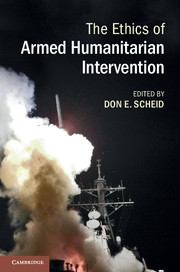Book contents
- Frontmatter
- Contents
- Notes on contributors
- Preface and acknowledgments
- List of abbreviations and acronyms
- Part I Intervention and debate
- Part II Moral perspectives
- Part III Ideas and reconsiderations
- 8 The costs of war
- 9 Armed humanitarian intervention and the problem of abuse after Libya
- 10 The responsibility to protect and the problem of regime change
- 11 Law, ethics, and the responsibility to protect
- 12 Responsibility to protect and the language of crimes
- 13 Post-intervention
- 14 Rethinking responsibility to protect
- Select bibliography
- Index
- References
12 - Responsibility to protect and the language of crimes
Collective action and individual culpability
Published online by Cambridge University Press: 05 June 2014
- Frontmatter
- Contents
- Notes on contributors
- Preface and acknowledgments
- List of abbreviations and acronyms
- Part I Intervention and debate
- Part II Moral perspectives
- Part III Ideas and reconsiderations
- 8 The costs of war
- 9 Armed humanitarian intervention and the problem of abuse after Libya
- 10 The responsibility to protect and the problem of regime change
- 11 Law, ethics, and the responsibility to protect
- 12 Responsibility to protect and the language of crimes
- 13 Post-intervention
- 14 Rethinking responsibility to protect
- Select bibliography
- Index
- References
Summary
The debate surrounding the legitimacy of armed humanitarian intervention often constructs a duel between those committed to the protection of individual rights and those concerned with preserving the rights of sovereign entities to non-interference. This framing, however, obscures the fact that there are three sets of ethical and legal norms that collide in situations of mass human suffering: the inviolability of state sovereignty (and the associated norm of territorial integrity); the right of individuals to be free of gross violations of their rights (particularly the right to life); and the just-war injunction against the use of force, except as a last resort. The latter principle, which arises from a sober recognition of the human suffering, physical destruction, and political and social instability that frequently accompanies the use of military force, is often forgotten in the heated exchanges between proponents of individual rights and the guardians of sovereign rights. Yet the imperative of last resort has become central to contemporary efforts to forge a consensus around the implementation of the principle of the Responsibility to Protect (RtoP), particularly in the wake of 2011 military action in Libya, which many countries in the global South viewed as an illegitimate extension of the mandate of civilian protection to the more contested objective of overthrowing the Gaddafi regime. A Brazilian government initiative, Responsibility while Protecting, is aimed at reinterpreting RtoP – and enhancing the consensus around it – by emphasizing the international community’s non-military options for exercising the norm, limiting the recourse to force to instances in which diplomatic and other means have been exhausted, and strengthening the accountability of those who act militarily on behalf of the Council.
Keywords
- Type
- Chapter
- Information
- The Ethics of Armed Humanitarian Intervention , pp. 209 - 223Publisher: Cambridge University PressPrint publication year: 2014

